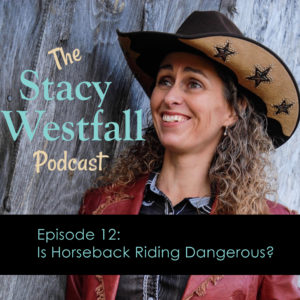Episode 12: Is Horseback Riding Dangerous?

Subscribe and never miss an episode! (I listen in the barn and when I’m out driving)
Subscribe For Free!
In this season, I am focusing on the rider’s body. In this episode, I’ll be discussing four different aspects of danger including is horseback riding dangerous, how can we manage the risk, the main mistake I see rider’s make, and exercises for improvement.
“You don't have to wait until you're in the middle of an emergency to practice things like emergency dismounts.” Stacy Westfall Click To TweetShow Notes
[02:01] We all know that horse riding can be dangerous.
[02:33] Driving in cars is also dangerous, and it’s something people do everyday.
[03:15] We realize there is risk, and we realize that we can do some things to reduce that risk.
[03:43] A horse without training can be like a car with a failing brake system.
[04:06] What creates danger? A rider that lacks training or a horse that lacks training are the two things where we can control the risk level.
[05:40] The way we can manage risk when riding is to physically hard wire a response into our bodies and our horse’s body.
[06:08] Our physical ability changes as we age. This changes how we have to think about and plan about hardwiring a response.
[07:05] I’ve taught people how to do an emergency dismounts and emergency stop and dismounts.
[08:31] You don’t have to wait until you’re in the middle of an emergency to practice things like emergency dismounts if you hard wire them into your body.

[09:43] It’s good for you and your horse to practice mounting and dismounting from both sides.
[10:24] Having these tactics hardwired into your body gives you a level of confidence if an emergency does happen.
[10:54] Mistakes people often make is not practicing the emergency stop and dismount or practicing too much and not moving forward.
[12:26] It’s a trend for people to learn to rely on the one rein stop. This is like using an emergency brake for your main braking system. Not practicing for emergencies at all is an equal problem.
[13:32] There is also a mental component to this. You need to have multiple ways to stop your horse. Finding the balance is really important.
[15:03] Switching the rider isn’t going to fix the problem of a horse that isn’t hardwired for a safe response.

[15:23] I don’t have to think about how to grab the saddle horn when riding.
[16:05] I don’t have to think about which direction I would take the horse’s head if I needed to bend the horse around.
[17:01] The third thing is a little more broad, it’s basically to move your expectations higher.
[17:44] Ask yourself if you can smoothly stop and get off quickly. If not, you need to evaluate if there is something you can change.
[18:12] What can you control that would make things better?
[18:30] Take your horse to the next level and move up to high school.
[18:45] If you are struggling with fears, write down your fears and determine which one points towards physical danger. Then make a plan and practice it.
“The way we can manage risk when riding is to physically hard wire a desired response into our bodies.” Stacy Westfall Click To TweetLinks and Resources:
Episode 1: Fear vs Danger: Riders can improve if they know the difference
Stacy’s Video Diary: Jac-Episode 1-First Day-Part 1-Evaluating Jac
6 Comments
Leave a Comment
SUBSCRIBE TO THE PODCAST HERE:





YOURS FREE
WHY IS MY HORSE...?





The emergency dismount is a great tool. I’m just wondering about the fine line there in determining if it’s an actual emergency. Is there a risk of unnecessarily getting off when the horse is doing something we don’t want? In other words might we be accidentally reinforcing unwanted behavior sometimes when really we need to work on our own fear level. I’m sure it varies with each and every rider but just wondering your thoughts on this.
You bring up a valid point. There is a chance of reinforcing unwanted behavior. The question becomes, can the rider who is in a high state of fear actually produce the desired result?
I find fewer people dismounting early as compared to people pushing themselves to keep riding ‘so the horse doesn’t learn to get away with it’…yet their lack of knowledge on how to stay safe during the correction is usually what is causing the fear.
For example, if the horse is threatening to rear…and the rider doesn’t have an effective method for changing this…staying on doesn’t have much chance of ‘fixing’ things. Without the understanding of what is going wrong and action steps of how to handle it, the rider is increasing their odds of injury by staying on without knowing the next step.
Maybe a shorter answer could be, if you execute an emergency dismount you should follow that up with increased learning about other ways you could handle the issue going forward.
Great points to ponder, thanks!
Thank you! Love love your podcasts. Love your work. I also still love bareback riding when I can and it’s nice to hear a trainer validate that. You are a great teacher. I use your clear concepts to help explain important points to riders that visit us (like soft/firm slow/fast hands) Hope that’s okay ?. Of course I also gush about your work and recommend they listen to your podcasts too.
I’m glad to help! Thanks for spreading the word and for making the world better for horses! The more people understand, the more the horses will benifit.
Yay! Season 2! I am so looking forward to it!
Stacy, this episode made me realize I have yet to teach my non-horseperson husband the emergency dismount. I taught him the “emergency brake” the first time he rode solo when we began dating, but we’ve just entered our 4th year of marriage – I’d better get on that dismount lesson! 😀 He rides very rarely but I always have every intention of setting him up for success – and safety – when he does join me!
Thank you again so much for providing us with this excellent podcast!
Sounds like a great plan! I’m starting Presto under saddle right now and it is a great reminder of practicing the dismount. Practicing holding the horn (unsteady horses are unbalanced) and practicing looking ahead for potential problems.
I wish someone had taught me the emergency dismount from my brother’s dirt bike…crashing worked but its the last dirt bike I rode!